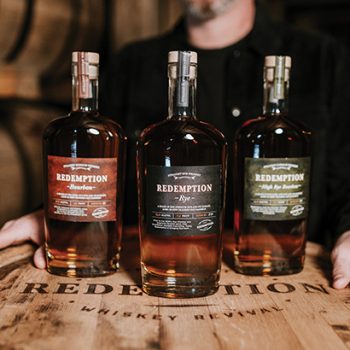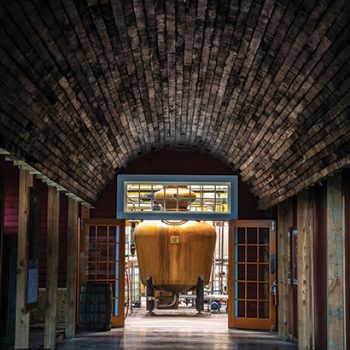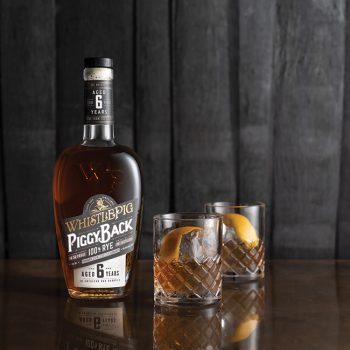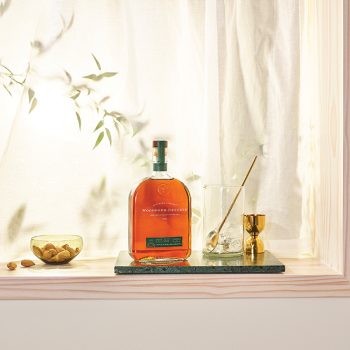This website uses cookies so that we can provide you with the best user experience possible. Cookie information is stored in your browser and performs functions such as recognising you when you return to our website and helping our team to understand which sections of the website you find most interesting and useful.
Rye smile: why America’s original spirit is on the up
By Nicola CarruthersDespite the challenges involved in creating rye whisky, producers are bullish about its potential for growth, and are keen to see it expand into an increasing number of global markets.

*This feature was originally published in the August 2023 issue of The Spirits Business magazine.
Often described as America’s original spirit, rye whiskey has a long history in the US, and is said to pre-date Bourbon by almost 200 years, according to the article The Rise and Fall and Rise of Rye by the late Dave Pickerell, WhistlePig’s master distiller.
Trade body the Distilled Spirits Council of the US (Discus) found that rye whisky volumes have soared by 1,275% between 2009 and 2019.
“Rye whiskey has been one of the best-performing spirits categories since 2009,” says Discus economist Hasan Bakir. “Its recent performance has also been strong, with supplier sales doubling to US$356 million in 2022 from US$175m in 2017. The rye whiskey category also did well relative to overall American whiskey, rising to 7% [share] in 2022 from less than 1% in 2009.”
Bakir also notes that the small subcategory still has room to grow. “Many rye brands benefitted from ongoing premiumisation trends due to their price profile,” he says. “While traditional spirits producers responded to meet demand by elevating their existing brands and introducing new ones, the proliferation of craft distilleries [in the US], from approximately 25 in 2000 to more than 2,600 today, has undoubtedly played a role in the growth of the rye whiskey category.”
Greg Mefford, international sales director for whiskey producer Luxco, says the category is “experiencing a real resurgence, and has huge growth potential”, driven by the on-trade. “Rye whiskey is an essential component of many classic American cocktails, meaning there’s high demand from mixologists,” he says. “There’s also growing appreciation of fuller-bodied American whiskeys, which have depth of flavour, spice, and warmth. Rye ticks these boxes.”

Alan Kennedy, master blender of Kentucky’s Redemption Whiskey, believes the category is “just starting to scratch the surface of how innovative it can be”. He expects to see more unique blending processes and whiskey variations as the category develops.
Mefford believes that the key to growing the category is by educating consumers about its diversity through tastings, whisky shows, and strong on-trade programmes.
In the past year, Luxco has seen double-digit growth for its portfolio of Indiana rye whiskeys. “Higher proofs and longer ageing are driving this growth, as well as consumer interest in provenance,” says Mefford. “The history of rye is steeped in Indiana distilling – something that interests whisky fans, and becomes something of a yardstick for authenticity, quality, and innovation.”
Outside of the US, Luxco has seen growth for its rye whiskey in the UK, Germany, and Australia. “We think this is because these are established whisky markets, where consumers are more accustomed to the warmth and fuller-taste profile of rye,” Mefford says. “We’re prioritising these markets for the export of Rossville Union, and expect to see growth opportunities for the brand in the next year.”
Luxco says it has also seen strong growth in Australia, and will launch its Rossville Union 6 Tear Bottled in Bond Rye Whiskey (50% ABV) in the market, Mefford adds.
Danish distiller Stauning, which uses locally grown rye for its whisky, has highlighted France, Germany, Denmark, and New York as its biggest markets, according to Alistair Reynolds, the brand’s global ambassador and head of advocacy.
Growth in Japan

Vermont rye whiskey producer WhistlePig has highlighted the UK, Japan, Korea, and Australia as “strong whiskey and Bourbon markets where rye would translate well”, its CEO Jeff Kozak says. “We are experiencing the most growth in Japan currently,” he adds. “Japan is an educated whisky market – there remains a shortage of high-quality single malt and American whiskey. We are also seeing growth in Korea. “I see the category in the rest of the world continuing to expand as the US market slows and larger brands concentrate their efforts overseas as more inventory becomes available.”
Kozak also plans to “build small hot spots of activity in countries like Dubai” as well as areas that “cover the top 50 bars and restaurants”.
Chris Morris, Brown-Forman’s master distiller emeritus, believes the long-term growth of the rye whiskey category in the US is dependent on a “thriving on-trade craft cocktail culture. Those markets that have limited cocktail innovation may find it difficult to grow the rye whiskey category.”
Morris says “established craft cocktail” markets such as the US, the UK, Germany, France, Australia, and Canada have been successful for Woodford Reserve Rye, which is “now one of the leading super-premium rye whiskeys in the US”.
When it comes to growing the category, Kozak says it is key that the brand work with ambassadors in each market. “We are building an army of advocacy with our ambassadors, and relaunching the League of the Flying Pig, which is where we appoint various bartenders and key individuals in each market to carry the WhistlePig brand message.”
 Kozak says the aim is for WhistlePig to “eventually be in 30 countries, in the top 100 bars/restaurants with a Maple Old Fashioned cocktail on each menu, and be the go-to call for the Old Fashioned in the American whiskey category”.
Kozak says the aim is for WhistlePig to “eventually be in 30 countries, in the top 100 bars/restaurants with a Maple Old Fashioned cocktail on each menu, and be the go-to call for the Old Fashioned in the American whiskey category”.
The brand is also planning to release more rye whiskey, alongside Bourbon and single malt, to enable WhistlePig to mature beyond being just a rye company, Kozak adds.
Reynolds is working to bring Stauning to the “best bars in the worlds”, and is working with venues in London such as Silverleaf. The brand has also partnered with acclaimed bartenders Alex Kratena, Matt Whiley, and Luke Whearty to host cocktail-making events featuring the bartending trio.
WhistlePig’s partnership with Moët Hennessy has also helped to boost sales, and expand its presence. Since selling a minority stake in the business to the major company in December 2020, WhistlePig has seen its volumes double each year, Kozak notes.
Challenges of using rye
While corn-based Bourbon often has a sweeter flavour profile, rye whiskey is spicier and more peppery than its whiskey counterparts. “Rye whiskey is more difficult to produce, as rye is more challenging to distil than corn is for a traditional Bourbon,” says Mefford. “Naturally, this does make it more expensive to produce, but the results are more than worth it.”
Woodford Reserve’s Morris notes that using large percentages of rye in a grain bill can be challenging. “The cooked grain mash will be more sticky than our classic Woodford Reserve Bourbon recipe with its predominant corn content,” Morris explains. “This makes cleaning our equipment more difficult, as is the transfer of liquid in the distillery. Also during fermentation, it foams more than the Bourbon mash so we have to scale back our volume levels in the fermenters. These factors add cost and complexity to the whiskey-making process beyond the fact that the cost of rye grain is more expensive than corn is.”
Woodford Reserve recently made a five-year commitment to buy grain from local farmers to bring rye production back to Kentucky, in partnership with the University of Kentucky. Over the years the brand has sourced its rye from Europe, Canada, and the northwestern US. Morris said the Kentucky initiative would help to reduce the distillery’s carbon footprint, and also help the local farming community.
Open-sourced variety
 Rye is said to be difficult to grow in Kentucky because of its generally warm, humid climate. As such, it is mainly sourced by distillers from the cooler climates of Canada or Europe. To overcome these challenges, more than US$1 million will be invested collectively by partners in the development of an open-sourced Kentucky variety during the course of Woodford Reserve’s research programme.
Rye is said to be difficult to grow in Kentucky because of its generally warm, humid climate. As such, it is mainly sourced by distillers from the cooler climates of Canada or Europe. To overcome these challenges, more than US$1 million will be invested collectively by partners in the development of an open-sourced Kentucky variety during the course of Woodford Reserve’s research programme.
“Historically Kentucky distillers were making rye whiskey as early as the 1820s. It was known as ‘Western rye’ in the industry because Kentucky was at that time the westernmost distilling region in the US,” Morris says. “Kentucky ‘Western rye’ was distinct from the ‘Eastern rye’ produced in Virginia, Maryland, Pennsylvania, and other coastal states due to its higher corn content. Therefore, it was more sweet and less spicy than the higher-rye-percentage recipes of the East Coast distillers.”
Morris notes the main concern of using Kentucky rye: “Will Kentucky-grown rye change the fermentation yield or change the flavour of Woodford Reserve? Therefore, the goal of the Kentucky initiative is to identify a rye strain that will be interchangeable with the current types commonly used today. We have been pleased with the results of our research.”
Rye whisky is also being made in countries such as Scotland, Germany, Sweden, Finland, and India, where the grain is being grown locally. “The more whiskey – not just rye – is produced globally, the more it benefits the category,” says Mefford. “Yes, it increases competition, but this is often offset by growing awareness of whisky and enhanced innovation.”
He continues: “It drives consumer interest and broadens the appeal of whisky – it’ll certainly help the growth of the rye whisky category.”
How do you see the rye whiskey category developing in the years to come?
Karthik Sudhir – founder and CEO, Phenomenal Spirits, owner of Ry3 Whiskey
“As more American whiskey consumers embrace rye whisky, the category is becoming widely accepted amongst enthusiasts and hardcore Bourbon drinkers. The growth is predominantly driven by two folds, mixologists using rye whiskey for craft cocktails and innovation in craft spirits sector with blends and distillates which is lot more approachable to Bourbon consumers. Rye whisky has been well received in southern US markets in Louisiana, Mississippi, Alabama, Georgia, Missouri, Tennessee, and several other predominant Bourbon whiskey markets. Whiskey drinkers are progressively seeking and exploring other subcategories of American whiskey. This interest and curiosity has led to a lot of Bourbon drinkers crossing over. The growing interest and demand is predominantly driven by the craft spirits industry producers and consumers.”

